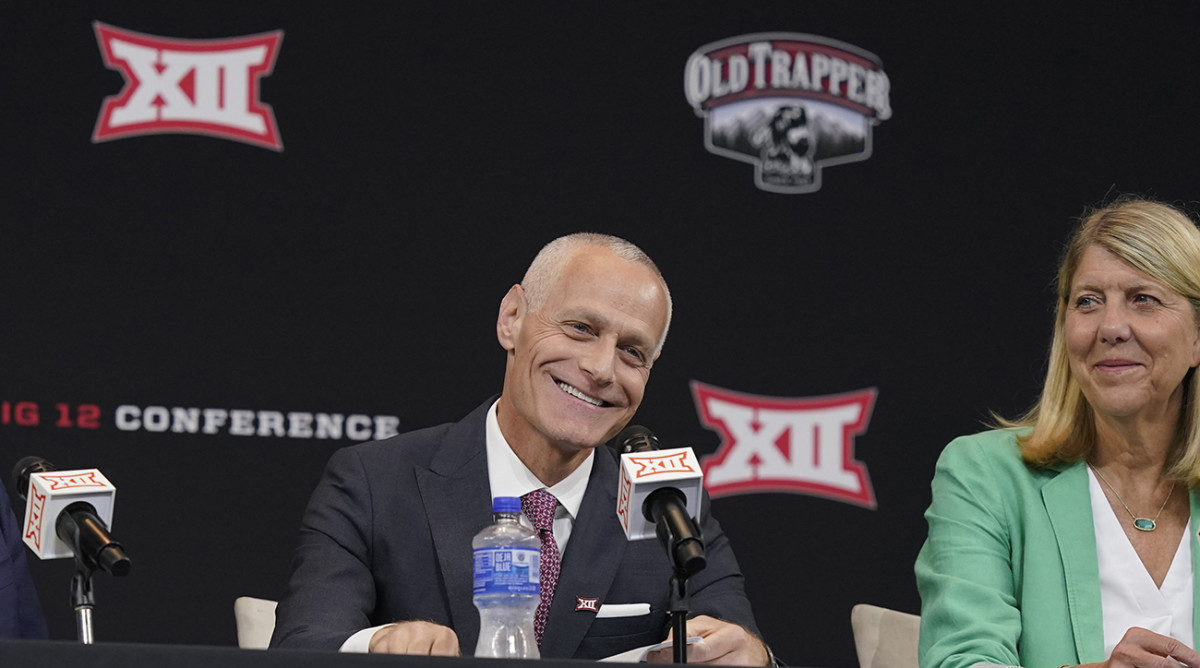The Big 12’s New Commissioner Knows the Score
ARLINGTON, Texas — Some respect, please, for new Big 12 commissioner Brett Yormark. He skipped the fake platitudes and went quickly to the real point at his introductory press conference here Wednesday.
“The Big 12 is open for business,” Yormark said, kicking off the conference’s football media days gathering at AT&T Stadium. “We will leave no stone unturned to drive value for the conference. … One thing is crystal clear: There is no higher priority than to best position the Big 12 for its upcoming multimedia rights negotiations. Everything we do must create momentum for those negotiations.”
This the reality of college athletics in 2022. You could send a million balloons into the sky with the hot air administrators spew about the “student-athlete experience” and “education” and “building character,” but the real priority for those in charge is turning the current piles of cash into larger piles of cash. Enter Yormark.
He seems to be the man for that job in this environment. The college sports world is changing to a more professionalized, cutthroat endeavor. So hiring a New Yorker with an NBA, NASCAR and entertainment background could provide benefits that flatten his geographic and collegiate learning curve. Finding good brisket and learning the school fight songs is far less urgent than navigating conference realignment and media rights.

Fortunately for Yormark, he’s inheriting a surprisingly stable league from outgoing commissioner Bob Bowlsby. Fifty-one weeks ago, everyone was writing a first draft of the Big 12’s obituary, so reaching this point alive and well is a pretty dramatic recovery.
When news broke that Texas and Oklahoma had finalized a move to the Southeastern Conference, a stunned and devalued Big 12 appeared primed for further poaching and eventual dissolution. But after the initial panic waves subsided, the remaining eight members of the league stuck together and then added four new schools: BYU, Central Florida, Cincinnati and Houston.
Strength in numbers, a further enhancement of the nation’s best men’s basketball league and solid enough football and TV markets gives the Big 12 a chance to survive further consolidation of the Power 5. The league is more stable than the most recent realignment victim, the Pac-12, which just lost USC and UCLA to the Big Ten. And its long-term viability may be better than the Atlantic Coast Conference, which is basically being held together by duct tape, baling wire and a long-term grant of rights deal.
As was reported last week, the Pac-12 and ACC are exploring a potential partnership (not a merger) that would center on broadcast inventory and involve ESPN. If the revenue estimates aren’t a game-changer and don’t produce an agreement, the Big 12 may intensify its pursuit of as many as six Pac-12 schools: Arizona, Arizona State, Colorado, Utah, Oregon and Washington.
“I think it’s fair to say I’ve received a lot of phone calls, a lot of interest,” Yormark said. “People understand the direction of the Big 12, and we’re exploring those levels of interest. Nothing is imminent, but we’re working hard to make sure that we position the Big 12 in the best possible way on a go-forward basis.”
Yormark did emphasize that expanding the conference membership would have to be “additive” and not “dilutive.” In other words, the schools coming in would each have to be worth as much in media rights revenue as the current group. If they don’t reach that financial benchmark, then the pie is being carved into smaller slices. The value of all the remaining Pac-12 schools is in question. There are no absolute slam dunks available to the Big 12.
Thus the task for Yormark could be improving the marketability of the hand he’s dealt. On several occasions he used the words “cooler, younger and hipper,” an area where there is little doubt the Big 12 could use some work. Appealing to recruits—and young viewers—could require some strategic shifts, and hiring a guy who worked at Jay-Z’s Roc Nation seems like a way to appeal to those demographics.
In terms of confidence and charisma, Yormark gives off the vibe of another New Yorker, Rick Pitino. It’s easy to see a committee of Big 12 leaders buying what he was selling in the interview process—one which Yormark said he believes he entered “as an underdog.” What he has to do now is sell his league as well as he sold himself.
In terms of where the balance of power is shifting nationally, the big question is whether a third (and possibly fourth) power league can come close to rivaling the growing power of the SEC and Big Ten. Oklahoma State coach Mike Gundy quoted a 52-year-old Carpenters song, “We’ve Only Just Begun,” in assessing what he thinks will happen in realignment. While that didn’t mesh with Yormark’s call for a “younger and hipper” league, it does underscore the belief that more consolidation is coming … sometime.
The Big 12’s outgoing commissioner, Bob Bowlsby—the consummate collegiate insider compared to Yormark’s outsider status—is fatalistic about that dynamic. “This isn’t any different than what’s happened in every small town in America,” Bowlsby said. “The corner drug store has gone away, the mom-and-pop grocery store has gone away. Capitalism is engulf and devour. That’s what we’re seeing in situations in college athletics. It’s the aggregation of resources.”
Thus the imperative for the leagues trying to survive in the shadow of the SEC and Big Ten seems clear: aggregate, or be aggregated. In a landscape where media-rights revenue rules all, Brett Yormark could be the right man for a tricky job leading the Big 12 forward. Time is money, and he wasted no time Wednesday talking about much of anything beyond making more money.
More College Coverage:
• USC, UCLA and Big Ten Get Theirs, but at What Cost?
• Deion Sanders Is Fueling the Rise of HBCU Football
• Notre Dame Will Play the Realignment Waiting Game—Because It Can
